|
|
Indeed, the bound-state quantum mechanics and
special relativity can be synthesized.
Thus, we can venture to ask whether Einstein's Lorentz covariance and
the Heisenberg brackets share the same mathematical base.
- The single variable Heisenberg bracket shares the same symmetry property with that
of the classical Poisson bracket. We can demonstrate this most effectively using
the Wigner function for the ground-state oscillator defined over the two-dimensional
space of position and momentum.
We can describe this Gaussian distribution using a circle around the origin of the
two-dimensional space of x and p. The amount of the fundamental uncertainty is
the area of the circle. The rotation of this circle does not change the area,
neither does the squeeze.
- Human brains are not configured to realize that the circle is a special case of
the ellipse. It took 1000 years for humans to realize the orbit of the sun or
earth is elliptic. It took many years for physicists appreciate this kind of
transformation.
The rotation plus squeeze is called "symplectic transformation." This word was
used first by Hermann Weyl in his book entitled
Classical Groups published in 1946 by the Princeton University Press, but Weyl
introduced this word in 1931 in one of his books written in German.
- As late as 1986, Eugene Wigner asked me what the symplectic group is. I told him
this word was introduced by Hermann Weyl. Wigner then told me he did not like
Weyl. This could be the reason why the symplectic transformation is not yet widely
known in the physics world.
- Another reason is that Goldstein in his textbook uses 40 pages to discuss
transformations of the Poisson brackets. We call them canonical transformations.
He mentions briefly symplect transformations. The canonoinical transformations are
more professionally treated in Arnold's book entitled
Mathematical Methods of Classical Mechanics.
However, the trouble with those books is the lack of graphical illustrations. It
took me several years to realize the symplectic transformation include area-preserving
linear transformations.
- As late as 1962, while Paul A. M. Dirac was finishing up
his 1963 paper on O(3,2), he was told by a younger colleague named Res Jost that
what he was doing was a symplectic group.
In 1962, both Dirac and Jost were
at the Institute for Advanced Study in Princeton.
In 1962, while Dirac visited
the University of Maryland, I was fortunate enough to spend some time with
him. I was like Nicodemus seeing Jesus (story from the Gospel of John of the New Testament).
I was a confused young physicist then.
Click here for a story.
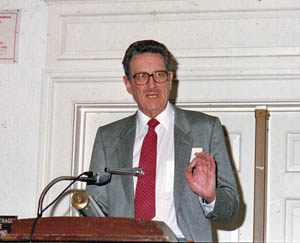
Lawrence C. Biedenharn
(photo taken in 1988).
|
- Then, do I have a brain different from other physicists? The answer is clearly NO.
I did a mathematical exercise telling the circle can be continuously squeezed into
an ellipse, while its area is being preserved. Click here
to see how I brag about my high-school background. I once thought this deformation
is all about the symplectic group and published a
paper based on my limited understanding of this subject. The referee and the editor
did not know what was wrong with this paper.
Larry Biedenharn scolded me by telling me that I have to include rotations.
I thank him for his guidance to the world of symplectic groups.
- The simplest way to understand the symplectic group is to start with
three two-by-two Pauli matrices:
[sigma]y, [sigma]x,
[sigma]z.
These matrices are Hermitian, and they correspond to the three generators of the
rotation group. Let us add the following three anti-Hermitian matrices.
i[sigma]y, i[sigma]x, i[sigma]z.
There are now six matrices. The Lie algebra of these matrics is the same as that
the Lorentz group applicable to the four-dimensional Minkkowski space of
(x, y, z, t). This is well known.
- It is not yet widely known that there are three imaginary matrices among the six
two-by-two matrices given above. They are
[sigma]y, i[sigma]x,
i[sigma]z.
These imaginary matrices satisfy a Lie algebra (closed set of commutation relations)
for Sp(2) group (two-dimensional symplectic group).
They generate two-by-two real matrices. With them, we can do a
two-dimensional geometry as shown in
this figure. Furthermore, their Lie algebra
is the same as that for the Lorentz group applicable
to one time-like dimension and two space-like directions, also as shown in
the same figure.
- While all these can be studied in terms of the single oscillator with the Wigner
function for the single oscillator, Dirac considered two oscillators, with bilinear
forms of the step-up and step-down operators.
|
|
|
Dirac then ended up with ten operators satisfying the Lie algebra for the
O(3,2) deSitter group,
which is the Lorentz group applicable
to three space-like and two time-like dimensions.
- What is this deStter grouip? Let us use (x, y, z) for
the space-like dimensions, and (t, s) for the time-like directions.
This group is the Lorentz group applicable to the five-dimensional space of
(x, y, z, t, ).
This O(3,2) group has its own merits in general relativity and other areas of physics.
Yet, we can ask whether whether
- this group can be constructed from the Heisenberg brackets for his uncertainty
principle,
- this group can be transformed into other symmetry problems in physics.
With these questions in mind,
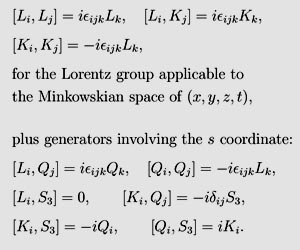
Lie algebra for the O(3,2) group.
|
|
- we can consider two Lorentz subgroups applicable to
(x, y, z, t) and
(x, y. z, s) respectively. Let us use
Li
for rotation
generators applicable to (x, y, z),
and use Ki for
the three boost generators with the time variable t. They are the six
generators for the Lorentz group familiar to all of us.
- There are four additional generators involving the extra time variable s.
We can use Qi
for the boost generators with respect to
time time-like variable s instead of t. In addition, there is one rotation
generator S3
which mixes up the s and t time-like variables.
- These ten generators constitute a closed set of commutation relations (Lie algebra)
for the O(3,2) group.
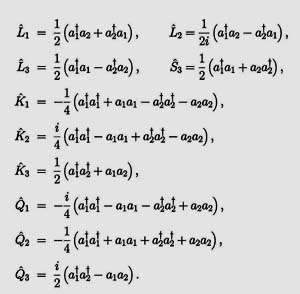
These operators satisfy the Lie algebra of the O(3,2) group.
Clearly this algebra is derivable from the Heisenberg brackets.
|
|
- Dirac,
in his paper of 1963, constructed the same Lie algebra of O(3,2) using the step-up and
step-down operators for two harmonic oscillators, and these generators are given
in this table. The question still is whether this
group can be transformed into other symmetry problems in physics.
To address this question, let us go to Dirac's earlier paper entitled
Forms of Relativistic Dynamics Published in 1949. In this paper,
he sates that the task of constructing quantum mechanics in the Lorentz-covariant
world is constructing a representation of the inhomogeneous Lorentz group
(Lorentz transformations in the three-dimensional space with one time variable)
plus four translation generators applicable to the four-dimensional Minkowski
space of (x, y, z, t) .
- The problem is then to leave the generators Ji
and Ki
intact, but
transform Qi and
S3
into four translation operators. This is not a difficult
problem. We can use the group contraction procedure to achieve this purpose.
In 2019, I was fortunate enough to write the following three papers on this subject.
- Einstein's E = mc2 derivable from Heisenberg's Uncertainty Relations,
with Sibel Baskal and Marilyn Noz,
Quantum Reports [1] (2), 236 - 251 (2019),
doi:10.3390/quantum1020021.
ArXiv. For pdf with sharper images,
click here.
- Role of Quantum Optics in Synthesizing Quantum Mechanics and Relativity,
Invited paper presented at the 26th
International Conference on Quantum Optics and Quantum Information
(Minsk, Belarus, May 2019).
ArXiv. For pdf with sharper images,
click here.
- Poincaré Symmetry from Heisenberg's Uncertainty Relations,
with S. Baskal and M. E. Noz,
Symmetry [11](3), 236 - 267 (2019),
doi:10.3390/sym11030409.
ArXiv.
In dealing with O(3,2) problems, we have to use many five-by-five matrices, and
they are cumbersome. The problem is how to translate them into the language of
two-by-two matrices.
|
| |
|
The squeezed Gaussian function plays the pivotal role quantum optics and
entanglement problems.
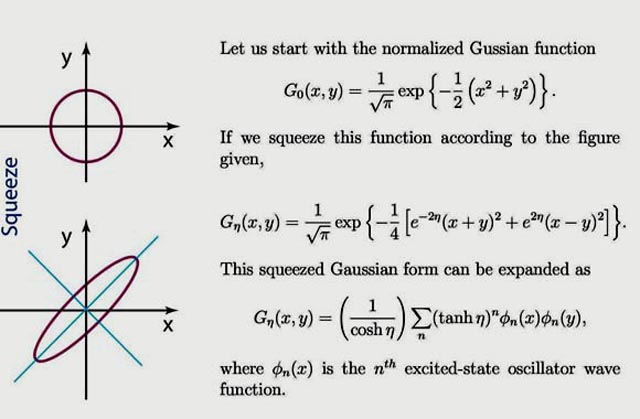
- The above figure and series expansion are clearly for the two-photon coherent
state. This figure tells clearly why this two-photon state is called
"squeezed state." This mathematics is a product of the Lorentz group,
as illustrated in this figure.
- This mathematics is in the current literature called the Gaussian entanglement.
- The concept of the entanglement was first formulated by Richard Feynman.
In his book on statistical
mechanics (1972), Feynman says
When we solve a quantum-mechanical problem, what we really do is
divide the universe into two parts - the system in which we are interested
and the rest of the universe. We then usually act as if the system in
which we are interested comprised the entire universe. To motivate the use
of density matrices, let us see what happens when we include the part of
the universe outside the system.
Feynman then used the density matrices and Wigner functions to illustrate
his rest of the universe. However, he used only one oscillator to
illustrate what he said about the rest of the universe. Yes! The harmonic
oscillator is the basic tool to illustrate the Wigner function. But how
could he explain two different worlds with one oscillator? Go to
this paper for clarification.
- The following figure explains that time-separation variable is not measurable,
and thus it belongs to the rest of the universe. In the physics of two photons,
they are entangled in the squeezed state, one of them is in the rest of the
universe if we do not measure it.
This figure serves also the case of two-photon
coherent state where one of the photons is not measured.
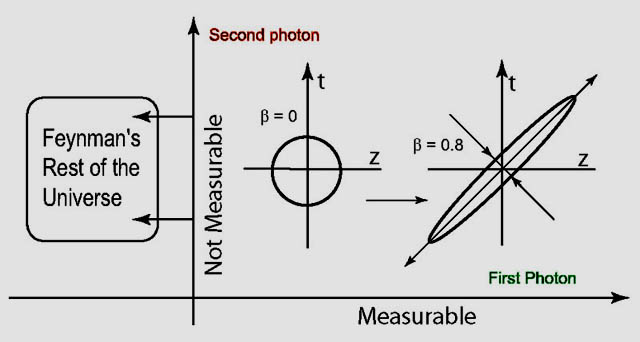
You may
click here for a detailed explanation of this figure.
|
|
|
|